Cloud Computing: Exploring Concepts, Security & Implementation
VerifiedAdded on 2023/06/12
|9
|2501
|71
Homework Assignment
AI Summary
This assignment provides a comprehensive overview of cloud computing, covering its fundamental concepts, security considerations, and practical implementation aspects. It begins by outlining the advantages of cloud computing, such as cost efficiency, automatic software integration, and quick deployment, while differentiating between public and private cloud models. The assignment further discusses the steps involved in implementing a private cloud, including financial planning, resource allocation, employee training, and hardware/software procurement. It delves into the role of System Center components like VMM, Operations Manager, and Service Manager in managing and monitoring cloud services. Additionally, the assignment addresses security threats in third-party data centers and emphasizes the importance of security considerations when choosing between private and public cloud solutions. It also explores the creation of private clouds using System Center Virtual Machine Manager, highlighting features like Intelligent Placement and centralized resource management. The document further explains virtual machine properties and VMM general settings, detailing the steps to create and enhance private cloud capabilities. Finally, it discusses the IT perspective of multi-tenancy, covering internal and external aspects, and client expectations regarding compliance, scalability, cost efficiency, and security in multi-tenant cloud environments. This document is available on Desklib, a platform providing a wide array of study resources for students.
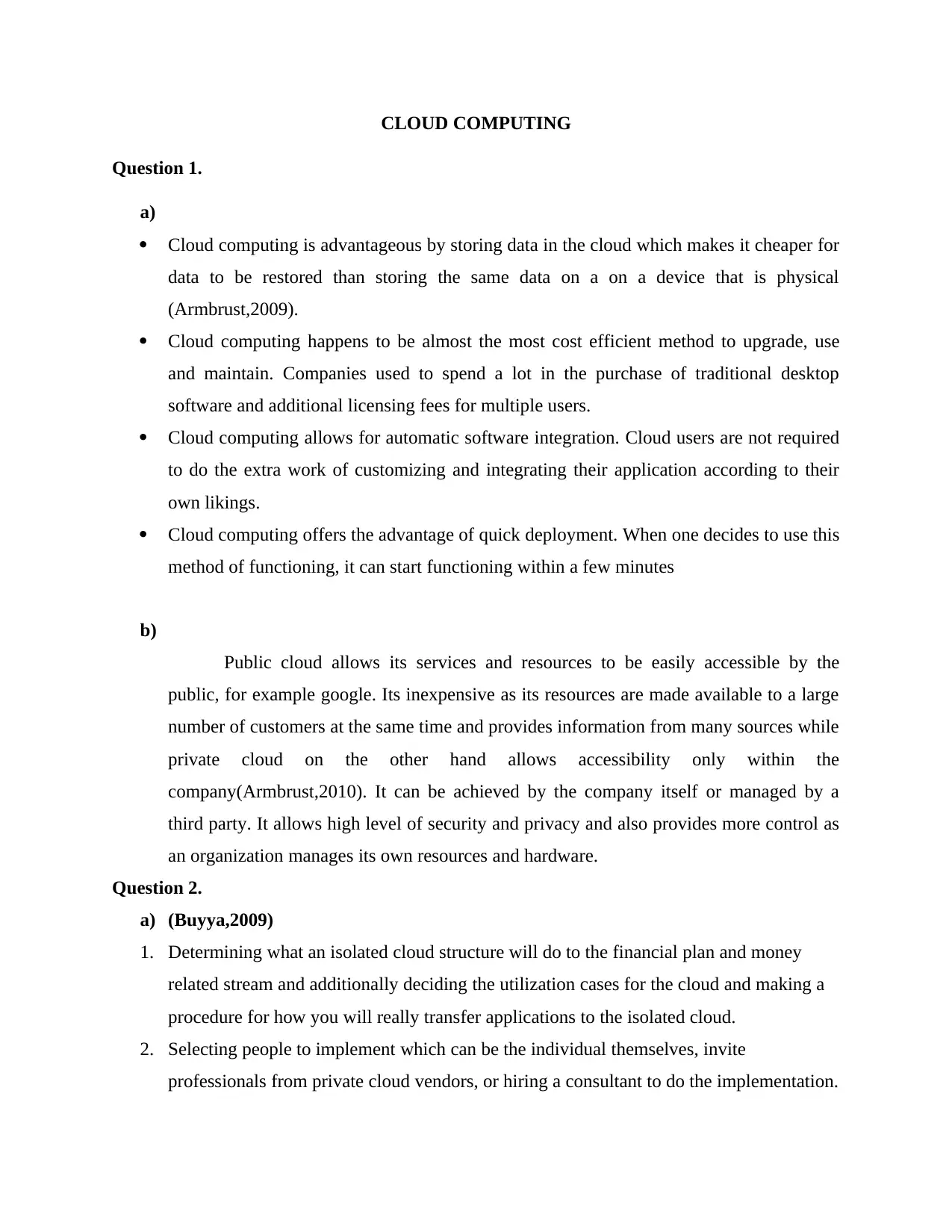
CLOUD COMPUTING
Question 1.
a)
Cloud computing is advantageous by storing data in the cloud which makes it cheaper for
data to be restored than storing the same data on a on a device that is physical
(Armbrust,2009).
Cloud computing happens to be almost the most cost efficient method to upgrade, use
and maintain. Companies used to spend a lot in the purchase of traditional desktop
software and additional licensing fees for multiple users.
Cloud computing allows for automatic software integration. Cloud users are not required
to do the extra work of customizing and integrating their application according to their
own likings.
Cloud computing offers the advantage of quick deployment. When one decides to use this
method of functioning, it can start functioning within a few minutes
b)
Public cloud allows its services and resources to be easily accessible by the
public, for example google. Its inexpensive as its resources are made available to a large
number of customers at the same time and provides information from many sources while
private cloud on the other hand allows accessibility only within the
company(Armbrust,2010). It can be achieved by the company itself or managed by a
third party. It allows high level of security and privacy and also provides more control as
an organization manages its own resources and hardware.
Question 2.
a) (Buyya,2009)
1. Determining what an isolated cloud structure will do to the financial plan and money
related stream and additionally deciding the utilization cases for the cloud and making a
procedure for how you will really transfer applications to the isolated cloud.
2. Selecting people to implement which can be the individual themselves, invite
professionals from private cloud vendors, or hiring a consultant to do the implementation.
Question 1.
a)
Cloud computing is advantageous by storing data in the cloud which makes it cheaper for
data to be restored than storing the same data on a on a device that is physical
(Armbrust,2009).
Cloud computing happens to be almost the most cost efficient method to upgrade, use
and maintain. Companies used to spend a lot in the purchase of traditional desktop
software and additional licensing fees for multiple users.
Cloud computing allows for automatic software integration. Cloud users are not required
to do the extra work of customizing and integrating their application according to their
own likings.
Cloud computing offers the advantage of quick deployment. When one decides to use this
method of functioning, it can start functioning within a few minutes
b)
Public cloud allows its services and resources to be easily accessible by the
public, for example google. Its inexpensive as its resources are made available to a large
number of customers at the same time and provides information from many sources while
private cloud on the other hand allows accessibility only within the
company(Armbrust,2010). It can be achieved by the company itself or managed by a
third party. It allows high level of security and privacy and also provides more control as
an organization manages its own resources and hardware.
Question 2.
a) (Buyya,2009)
1. Determining what an isolated cloud structure will do to the financial plan and money
related stream and additionally deciding the utilization cases for the cloud and making a
procedure for how you will really transfer applications to the isolated cloud.
2. Selecting people to implement which can be the individual themselves, invite
professionals from private cloud vendors, or hiring a consultant to do the implementation.
Paraphrase This Document
Need a fresh take? Get an instant paraphrase of this document with our AI Paraphraser
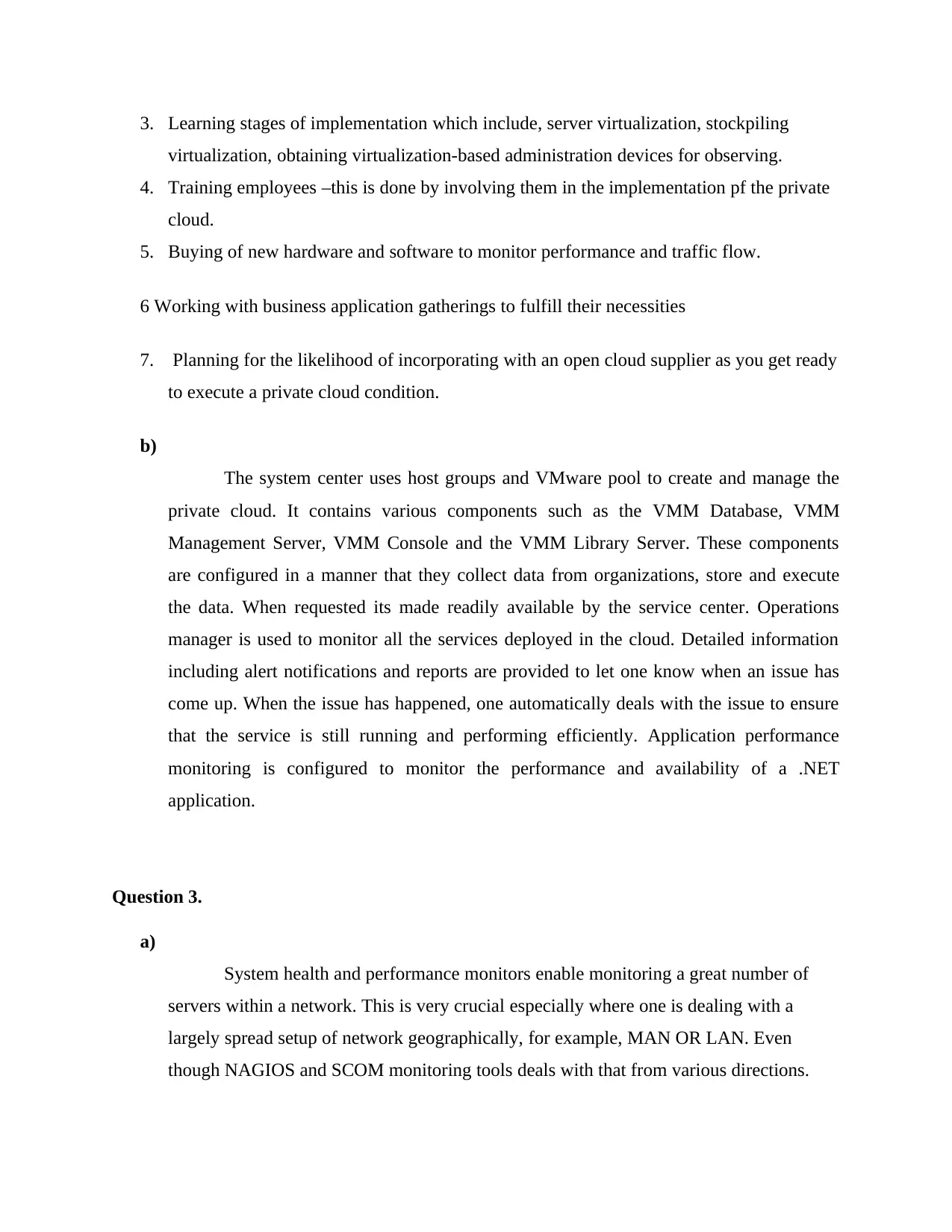
3. Learning stages of implementation which include, server virtualization, stockpiling
virtualization, obtaining virtualization-based administration devices for observing.
4. Training employees –this is done by involving them in the implementation pf the private
cloud.
5. Buying of new hardware and software to monitor performance and traffic flow.
6 Working with business application gatherings to fulfill their necessities
7. Planning for the likelihood of incorporating with an open cloud supplier as you get ready
to execute a private cloud condition.
b)
The system center uses host groups and VMware pool to create and manage the
private cloud. It contains various components such as the VMM Database, VMM
Management Server, VMM Console and the VMM Library Server. These components
are configured in a manner that they collect data from organizations, store and execute
the data. When requested its made readily available by the service center. Operations
manager is used to monitor all the services deployed in the cloud. Detailed information
including alert notifications and reports are provided to let one know when an issue has
come up. When the issue has happened, one automatically deals with the issue to ensure
that the service is still running and performing efficiently. Application performance
monitoring is configured to monitor the performance and availability of a .NET
application.
Question 3.
a)
System health and performance monitors enable monitoring a great number of
servers within a network. This is very crucial especially where one is dealing with a
largely spread setup of network geographically, for example, MAN OR LAN. Even
though NAGIOS and SCOM monitoring tools deals with that from various directions.
virtualization, obtaining virtualization-based administration devices for observing.
4. Training employees –this is done by involving them in the implementation pf the private
cloud.
5. Buying of new hardware and software to monitor performance and traffic flow.
6 Working with business application gatherings to fulfill their necessities
7. Planning for the likelihood of incorporating with an open cloud supplier as you get ready
to execute a private cloud condition.
b)
The system center uses host groups and VMware pool to create and manage the
private cloud. It contains various components such as the VMM Database, VMM
Management Server, VMM Console and the VMM Library Server. These components
are configured in a manner that they collect data from organizations, store and execute
the data. When requested its made readily available by the service center. Operations
manager is used to monitor all the services deployed in the cloud. Detailed information
including alert notifications and reports are provided to let one know when an issue has
come up. When the issue has happened, one automatically deals with the issue to ensure
that the service is still running and performing efficiently. Application performance
monitoring is configured to monitor the performance and availability of a .NET
application.
Question 3.
a)
System health and performance monitors enable monitoring a great number of
servers within a network. This is very crucial especially where one is dealing with a
largely spread setup of network geographically, for example, MAN OR LAN. Even
though NAGIOS and SCOM monitoring tools deals with that from various directions.
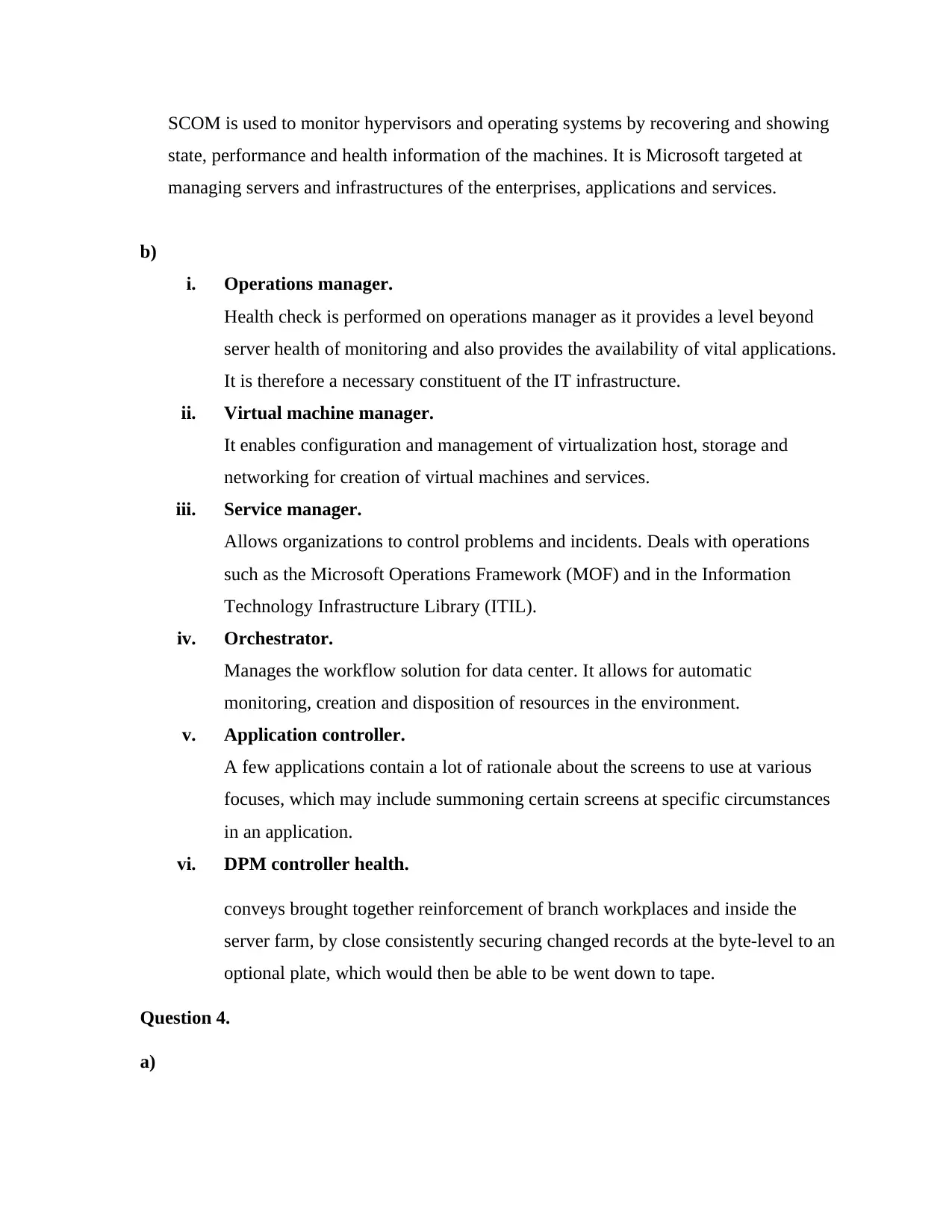
SCOM is used to monitor hypervisors and operating systems by recovering and showing
state, performance and health information of the machines. It is Microsoft targeted at
managing servers and infrastructures of the enterprises, applications and services.
b)
i. Operations manager.
Health check is performed on operations manager as it provides a level beyond
server health of monitoring and also provides the availability of vital applications.
It is therefore a necessary constituent of the IT infrastructure.
ii. Virtual machine manager.
It enables configuration and management of virtualization host, storage and
networking for creation of virtual machines and services.
iii. Service manager.
Allows organizations to control problems and incidents. Deals with operations
such as the Microsoft Operations Framework (MOF) and in the Information
Technology Infrastructure Library (ITIL).
iv. Orchestrator.
Manages the workflow solution for data center. It allows for automatic
monitoring, creation and disposition of resources in the environment.
v. Application controller.
A few applications contain a lot of rationale about the screens to use at various
focuses, which may include summoning certain screens at specific circumstances
in an application.
vi. DPM controller health.
conveys brought together reinforcement of branch workplaces and inside the
server farm, by close consistently securing changed records at the byte-level to an
optional plate, which would then be able to be went down to tape.
Question 4.
a)
state, performance and health information of the machines. It is Microsoft targeted at
managing servers and infrastructures of the enterprises, applications and services.
b)
i. Operations manager.
Health check is performed on operations manager as it provides a level beyond
server health of monitoring and also provides the availability of vital applications.
It is therefore a necessary constituent of the IT infrastructure.
ii. Virtual machine manager.
It enables configuration and management of virtualization host, storage and
networking for creation of virtual machines and services.
iii. Service manager.
Allows organizations to control problems and incidents. Deals with operations
such as the Microsoft Operations Framework (MOF) and in the Information
Technology Infrastructure Library (ITIL).
iv. Orchestrator.
Manages the workflow solution for data center. It allows for automatic
monitoring, creation and disposition of resources in the environment.
v. Application controller.
A few applications contain a lot of rationale about the screens to use at various
focuses, which may include summoning certain screens at specific circumstances
in an application.
vi. DPM controller health.
conveys brought together reinforcement of branch workplaces and inside the
server farm, by close consistently securing changed records at the byte-level to an
optional plate, which would then be able to be went down to tape.
Question 4.
a)
⊘ This is a preview!⊘
Do you want full access?
Subscribe today to unlock all pages.

Trusted by 1+ million students worldwide
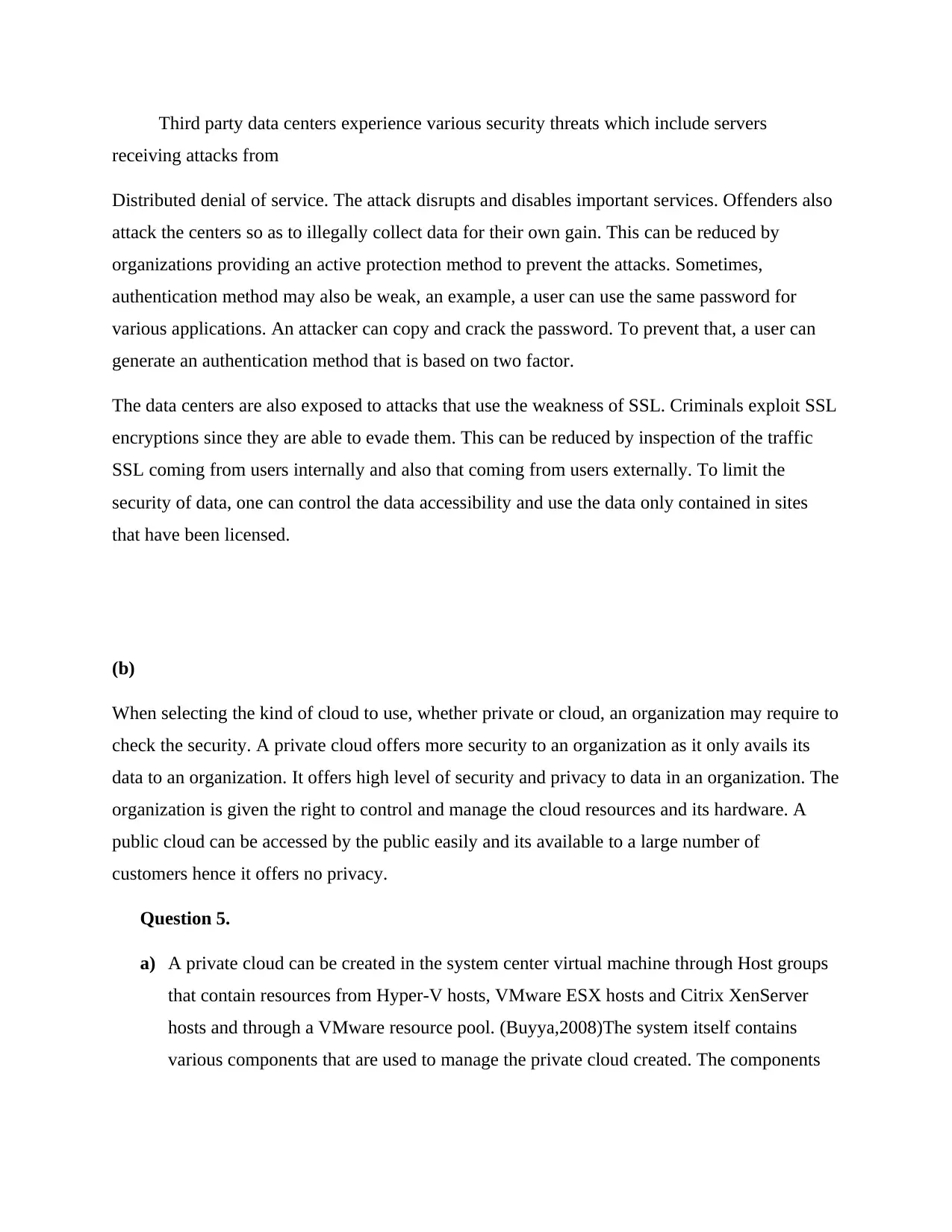
Third party data centers experience various security threats which include servers
receiving attacks from
Distributed denial of service. The attack disrupts and disables important services. Offenders also
attack the centers so as to illegally collect data for their own gain. This can be reduced by
organizations providing an active protection method to prevent the attacks. Sometimes,
authentication method may also be weak, an example, a user can use the same password for
various applications. An attacker can copy and crack the password. To prevent that, a user can
generate an authentication method that is based on two factor.
The data centers are also exposed to attacks that use the weakness of SSL. Criminals exploit SSL
encryptions since they are able to evade them. This can be reduced by inspection of the traffic
SSL coming from users internally and also that coming from users externally. To limit the
security of data, one can control the data accessibility and use the data only contained in sites
that have been licensed.
(b)
When selecting the kind of cloud to use, whether private or cloud, an organization may require to
check the security. A private cloud offers more security to an organization as it only avails its
data to an organization. It offers high level of security and privacy to data in an organization. The
organization is given the right to control and manage the cloud resources and its hardware. A
public cloud can be accessed by the public easily and its available to a large number of
customers hence it offers no privacy.
Question 5.
a) A private cloud can be created in the system center virtual machine through Host groups
that contain resources from Hyper-V hosts, VMware ESX hosts and Citrix XenServer
hosts and through a VMware resource pool. (Buyya,2008)The system itself contains
various components that are used to manage the private cloud created. The components
receiving attacks from
Distributed denial of service. The attack disrupts and disables important services. Offenders also
attack the centers so as to illegally collect data for their own gain. This can be reduced by
organizations providing an active protection method to prevent the attacks. Sometimes,
authentication method may also be weak, an example, a user can use the same password for
various applications. An attacker can copy and crack the password. To prevent that, a user can
generate an authentication method that is based on two factor.
The data centers are also exposed to attacks that use the weakness of SSL. Criminals exploit SSL
encryptions since they are able to evade them. This can be reduced by inspection of the traffic
SSL coming from users internally and also that coming from users externally. To limit the
security of data, one can control the data accessibility and use the data only contained in sites
that have been licensed.
(b)
When selecting the kind of cloud to use, whether private or cloud, an organization may require to
check the security. A private cloud offers more security to an organization as it only avails its
data to an organization. It offers high level of security and privacy to data in an organization. The
organization is given the right to control and manage the cloud resources and its hardware. A
public cloud can be accessed by the public easily and its available to a large number of
customers hence it offers no privacy.
Question 5.
a) A private cloud can be created in the system center virtual machine through Host groups
that contain resources from Hyper-V hosts, VMware ESX hosts and Citrix XenServer
hosts and through a VMware resource pool. (Buyya,2008)The system itself contains
various components that are used to manage the private cloud created. The components
Paraphrase This Document
Need a fresh take? Get an instant paraphrase of this document with our AI Paraphraser
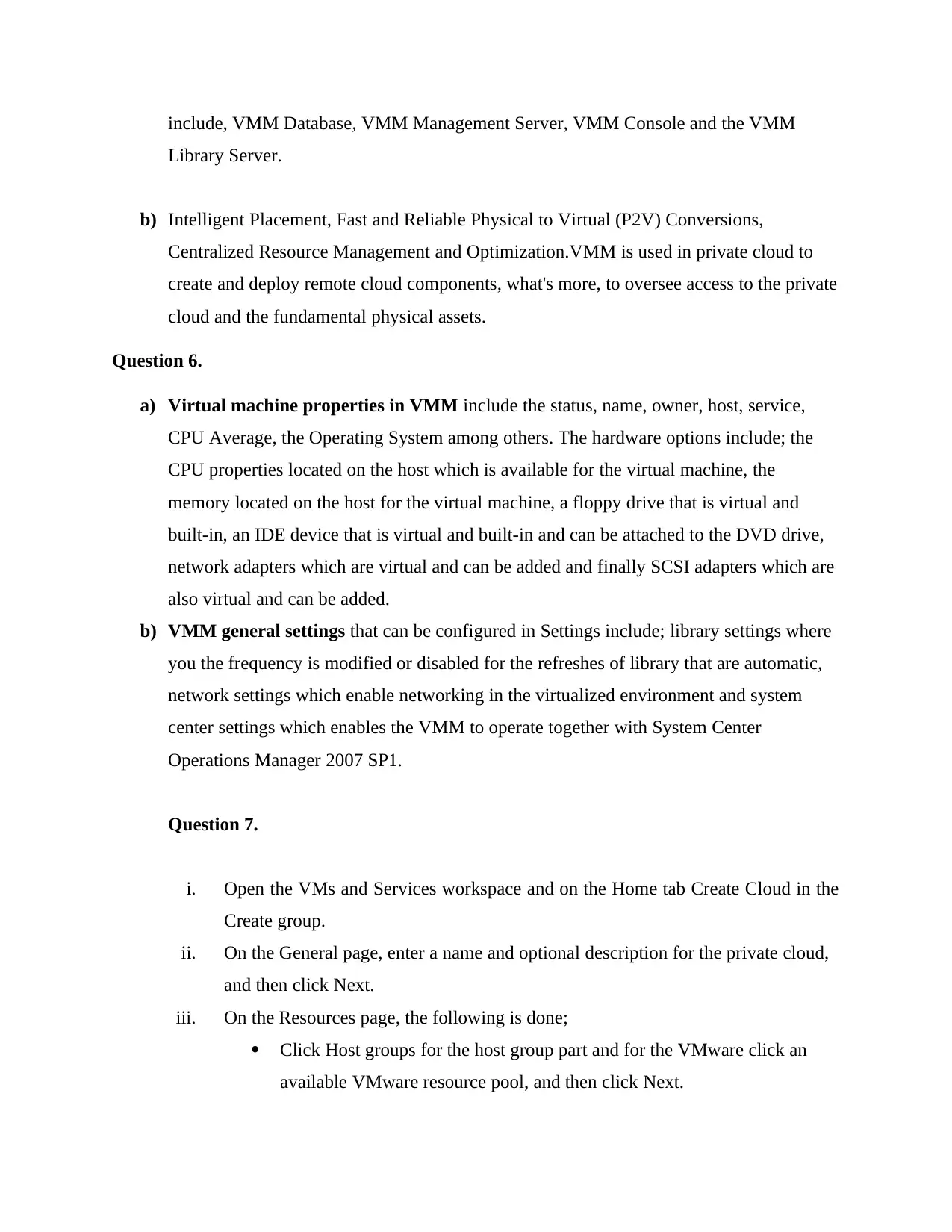
include, VMM Database, VMM Management Server, VMM Console and the VMM
Library Server.
b) Intelligent Placement, Fast and Reliable Physical to Virtual (P2V) Conversions,
Centralized Resource Management and Optimization.VMM is used in private cloud to
create and deploy remote cloud components, what's more, to oversee access to the private
cloud and the fundamental physical assets.
Question 6.
a) Virtual machine properties in VMM include the status, name, owner, host, service,
CPU Average, the Operating System among others. The hardware options include; the
CPU properties located on the host which is available for the virtual machine, the
memory located on the host for the virtual machine, a floppy drive that is virtual and
built-in, an IDE device that is virtual and built-in and can be attached to the DVD drive,
network adapters which are virtual and can be added and finally SCSI adapters which are
also virtual and can be added.
b) VMM general settings that can be configured in Settings include; library settings where
you the frequency is modified or disabled for the refreshes of library that are automatic,
network settings which enable networking in the virtualized environment and system
center settings which enables the VMM to operate together with System Center
Operations Manager 2007 SP1.
Question 7.
i. Open the VMs and Services workspace and on the Home tab Create Cloud in the
Create group.
ii. On the General page, enter a name and optional description for the private cloud,
and then click Next.
iii. On the Resources page, the following is done;
Click Host groups for the host group part and for the VMware click an
available VMware resource pool, and then click Next.
Library Server.
b) Intelligent Placement, Fast and Reliable Physical to Virtual (P2V) Conversions,
Centralized Resource Management and Optimization.VMM is used in private cloud to
create and deploy remote cloud components, what's more, to oversee access to the private
cloud and the fundamental physical assets.
Question 6.
a) Virtual machine properties in VMM include the status, name, owner, host, service,
CPU Average, the Operating System among others. The hardware options include; the
CPU properties located on the host which is available for the virtual machine, the
memory located on the host for the virtual machine, a floppy drive that is virtual and
built-in, an IDE device that is virtual and built-in and can be attached to the DVD drive,
network adapters which are virtual and can be added and finally SCSI adapters which are
also virtual and can be added.
b) VMM general settings that can be configured in Settings include; library settings where
you the frequency is modified or disabled for the refreshes of library that are automatic,
network settings which enable networking in the virtualized environment and system
center settings which enables the VMM to operate together with System Center
Operations Manager 2007 SP1.
Question 7.
i. Open the VMs and Services workspace and on the Home tab Create Cloud in the
Create group.
ii. On the General page, enter a name and optional description for the private cloud,
and then click Next.
iii. On the Resources page, the following is done;
Click Host groups for the host group part and for the VMware click an
available VMware resource pool, and then click Next.
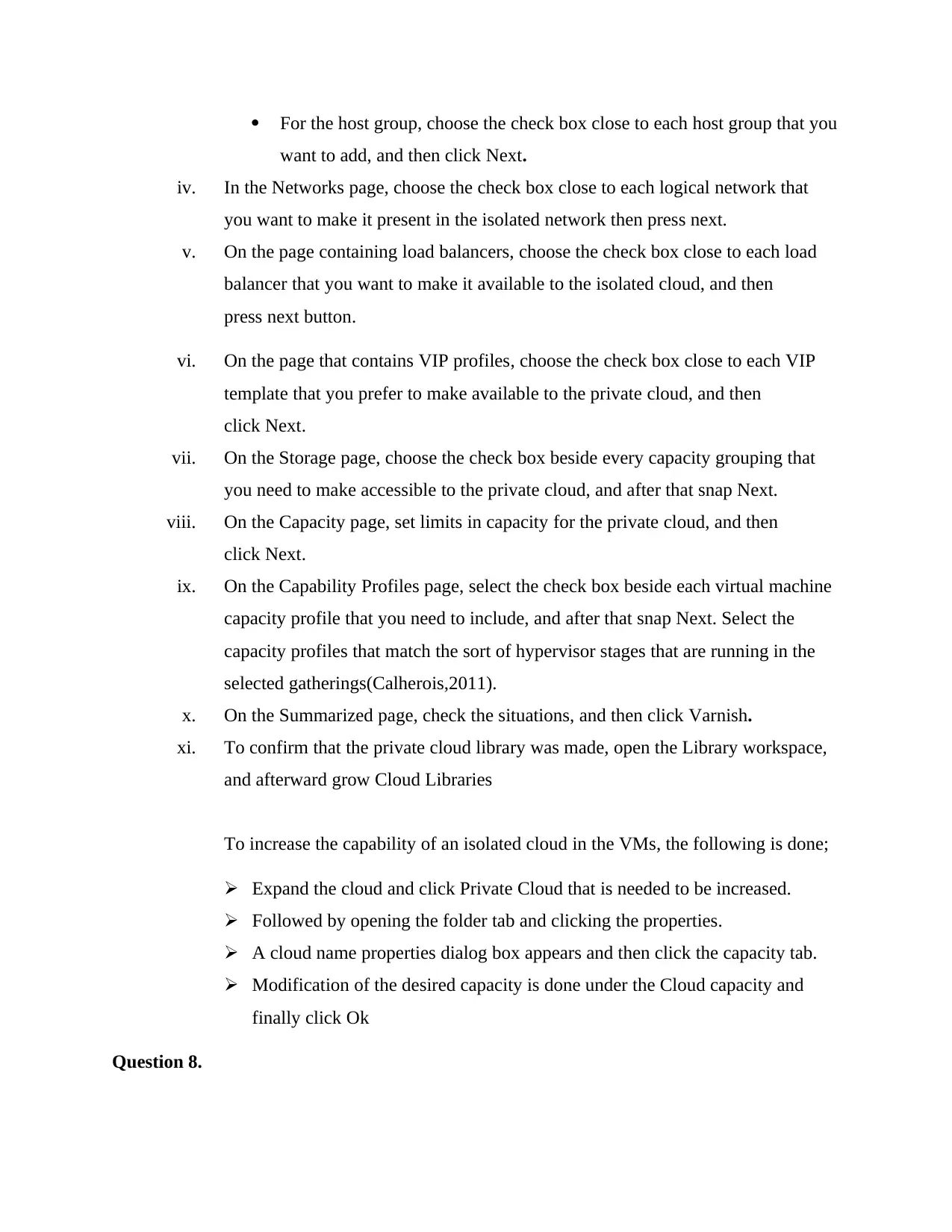
For the host group, choose the check box close to each host group that you
want to add, and then click Next.
iv. In the Networks page, choose the check box close to each logical network that
you want to make it present in the isolated network then press next.
v. On the page containing load balancers, choose the check box close to each load
balancer that you want to make it available to the isolated cloud, and then
press next button.
vi. On the page that contains VIP profiles, choose the check box close to each VIP
template that you prefer to make available to the private cloud, and then
click Next.
vii. On the Storage page, choose the check box beside every capacity grouping that
you need to make accessible to the private cloud, and after that snap Next.
viii. On the Capacity page, set limits in capacity for the private cloud, and then
click Next.
ix. On the Capability Profiles page, select the check box beside each virtual machine
capacity profile that you need to include, and after that snap Next. Select the
capacity profiles that match the sort of hypervisor stages that are running in the
selected gatherings(Calherois,2011).
x. On the Summarized page, check the situations, and then click Varnish.
xi. To confirm that the private cloud library was made, open the Library workspace,
and afterward grow Cloud Libraries
To increase the capability of an isolated cloud in the VMs, the following is done;
Expand the cloud and click Private Cloud that is needed to be increased.
Followed by opening the folder tab and clicking the properties.
A cloud name properties dialog box appears and then click the capacity tab.
Modification of the desired capacity is done under the Cloud capacity and
finally click Ok
Question 8.
want to add, and then click Next.
iv. In the Networks page, choose the check box close to each logical network that
you want to make it present in the isolated network then press next.
v. On the page containing load balancers, choose the check box close to each load
balancer that you want to make it available to the isolated cloud, and then
press next button.
vi. On the page that contains VIP profiles, choose the check box close to each VIP
template that you prefer to make available to the private cloud, and then
click Next.
vii. On the Storage page, choose the check box beside every capacity grouping that
you need to make accessible to the private cloud, and after that snap Next.
viii. On the Capacity page, set limits in capacity for the private cloud, and then
click Next.
ix. On the Capability Profiles page, select the check box beside each virtual machine
capacity profile that you need to include, and after that snap Next. Select the
capacity profiles that match the sort of hypervisor stages that are running in the
selected gatherings(Calherois,2011).
x. On the Summarized page, check the situations, and then click Varnish.
xi. To confirm that the private cloud library was made, open the Library workspace,
and afterward grow Cloud Libraries
To increase the capability of an isolated cloud in the VMs, the following is done;
Expand the cloud and click Private Cloud that is needed to be increased.
Followed by opening the folder tab and clicking the properties.
A cloud name properties dialog box appears and then click the capacity tab.
Modification of the desired capacity is done under the Cloud capacity and
finally click Ok
Question 8.
⊘ This is a preview!⊘
Do you want full access?
Subscribe today to unlock all pages.

Trusted by 1+ million students worldwide
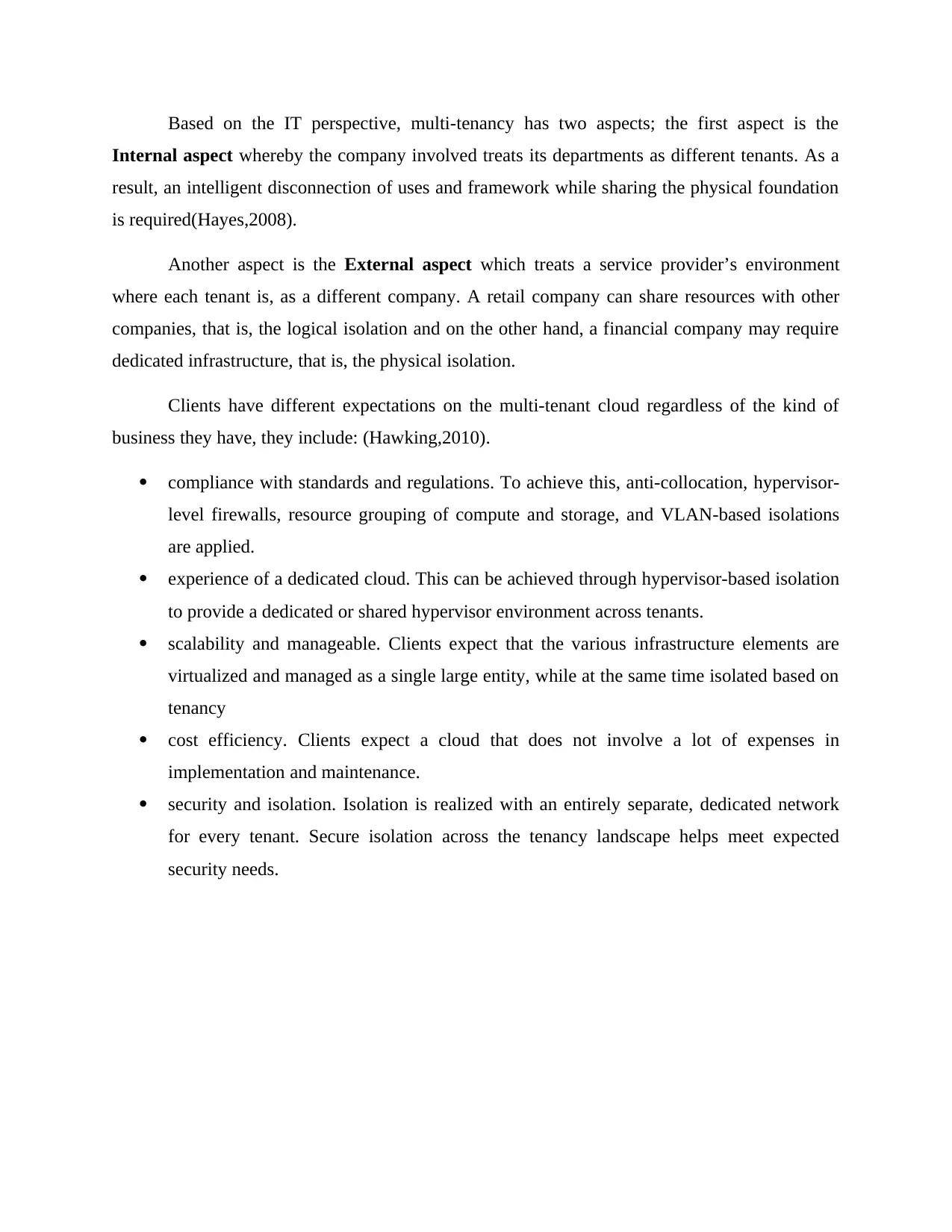
Based on the IT perspective, multi-tenancy has two aspects; the first aspect is the
Internal aspect whereby the company involved treats its departments as different tenants. As a
result, an intelligent disconnection of uses and framework while sharing the physical foundation
is required(Hayes,2008).
Another aspect is the External aspect which treats a service provider’s environment
where each tenant is, as a different company. A retail company can share resources with other
companies, that is, the logical isolation and on the other hand, a financial company may require
dedicated infrastructure, that is, the physical isolation.
Clients have different expectations on the multi-tenant cloud regardless of the kind of
business they have, they include: (Hawking,2010).
compliance with standards and regulations. To achieve this, anti-collocation, hypervisor-
level firewalls, resource grouping of compute and storage, and VLAN-based isolations
are applied.
experience of a dedicated cloud. This can be achieved through hypervisor-based isolation
to provide a dedicated or shared hypervisor environment across tenants.
scalability and manageable. Clients expect that the various infrastructure elements are
virtualized and managed as a single large entity, while at the same time isolated based on
tenancy
cost efficiency. Clients expect a cloud that does not involve a lot of expenses in
implementation and maintenance.
security and isolation. Isolation is realized with an entirely separate, dedicated network
for every tenant. Secure isolation across the tenancy landscape helps meet expected
security needs.
Internal aspect whereby the company involved treats its departments as different tenants. As a
result, an intelligent disconnection of uses and framework while sharing the physical foundation
is required(Hayes,2008).
Another aspect is the External aspect which treats a service provider’s environment
where each tenant is, as a different company. A retail company can share resources with other
companies, that is, the logical isolation and on the other hand, a financial company may require
dedicated infrastructure, that is, the physical isolation.
Clients have different expectations on the multi-tenant cloud regardless of the kind of
business they have, they include: (Hawking,2010).
compliance with standards and regulations. To achieve this, anti-collocation, hypervisor-
level firewalls, resource grouping of compute and storage, and VLAN-based isolations
are applied.
experience of a dedicated cloud. This can be achieved through hypervisor-based isolation
to provide a dedicated or shared hypervisor environment across tenants.
scalability and manageable. Clients expect that the various infrastructure elements are
virtualized and managed as a single large entity, while at the same time isolated based on
tenancy
cost efficiency. Clients expect a cloud that does not involve a lot of expenses in
implementation and maintenance.
security and isolation. Isolation is realized with an entirely separate, dedicated network
for every tenant. Secure isolation across the tenancy landscape helps meet expected
security needs.
Paraphrase This Document
Need a fresh take? Get an instant paraphrase of this document with our AI Paraphraser
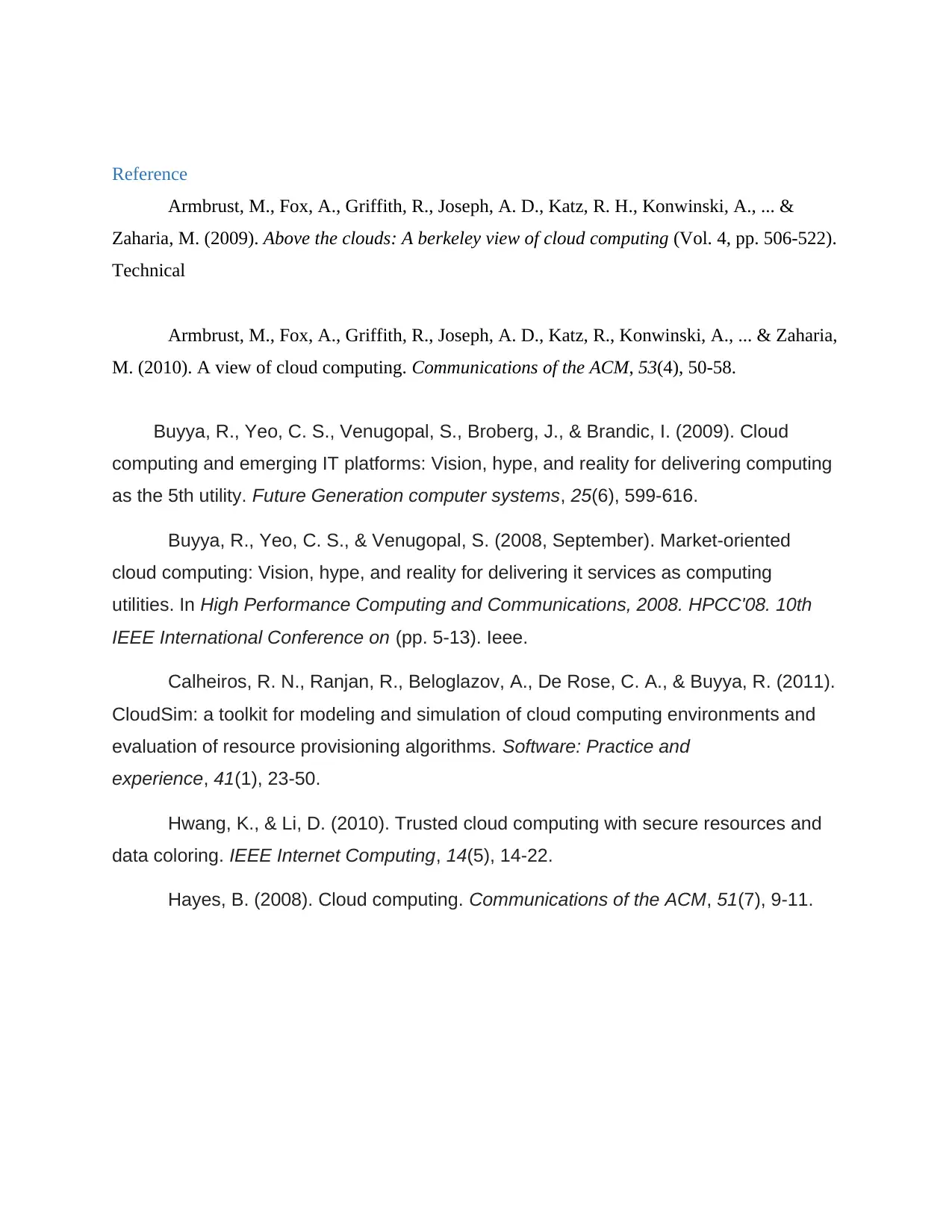
Reference
Armbrust, M., Fox, A., Griffith, R., Joseph, A. D., Katz, R. H., Konwinski, A., ... &
Zaharia, M. (2009). Above the clouds: A berkeley view of cloud computing (Vol. 4, pp. 506-522).
Technical
Armbrust, M., Fox, A., Griffith, R., Joseph, A. D., Katz, R., Konwinski, A., ... & Zaharia,
M. (2010). A view of cloud computing. Communications of the ACM, 53(4), 50-58.
Buyya, R., Yeo, C. S., Venugopal, S., Broberg, J., & Brandic, I. (2009). Cloud
computing and emerging IT platforms: Vision, hype, and reality for delivering computing
as the 5th utility. Future Generation computer systems, 25(6), 599-616.
Buyya, R., Yeo, C. S., & Venugopal, S. (2008, September). Market-oriented
cloud computing: Vision, hype, and reality for delivering it services as computing
utilities. In High Performance Computing and Communications, 2008. HPCC'08. 10th
IEEE International Conference on (pp. 5-13). Ieee.
Calheiros, R. N., Ranjan, R., Beloglazov, A., De Rose, C. A., & Buyya, R. (2011).
CloudSim: a toolkit for modeling and simulation of cloud computing environments and
evaluation of resource provisioning algorithms. Software: Practice and
experience, 41(1), 23-50.
Hwang, K., & Li, D. (2010). Trusted cloud computing with secure resources and
data coloring. IEEE Internet Computing, 14(5), 14-22.
Hayes, B. (2008). Cloud computing. Communications of the ACM, 51(7), 9-11.
Armbrust, M., Fox, A., Griffith, R., Joseph, A. D., Katz, R. H., Konwinski, A., ... &
Zaharia, M. (2009). Above the clouds: A berkeley view of cloud computing (Vol. 4, pp. 506-522).
Technical
Armbrust, M., Fox, A., Griffith, R., Joseph, A. D., Katz, R., Konwinski, A., ... & Zaharia,
M. (2010). A view of cloud computing. Communications of the ACM, 53(4), 50-58.
Buyya, R., Yeo, C. S., Venugopal, S., Broberg, J., & Brandic, I. (2009). Cloud
computing and emerging IT platforms: Vision, hype, and reality for delivering computing
as the 5th utility. Future Generation computer systems, 25(6), 599-616.
Buyya, R., Yeo, C. S., & Venugopal, S. (2008, September). Market-oriented
cloud computing: Vision, hype, and reality for delivering it services as computing
utilities. In High Performance Computing and Communications, 2008. HPCC'08. 10th
IEEE International Conference on (pp. 5-13). Ieee.
Calheiros, R. N., Ranjan, R., Beloglazov, A., De Rose, C. A., & Buyya, R. (2011).
CloudSim: a toolkit for modeling and simulation of cloud computing environments and
evaluation of resource provisioning algorithms. Software: Practice and
experience, 41(1), 23-50.
Hwang, K., & Li, D. (2010). Trusted cloud computing with secure resources and
data coloring. IEEE Internet Computing, 14(5), 14-22.
Hayes, B. (2008). Cloud computing. Communications of the ACM, 51(7), 9-11.

⊘ This is a preview!⊘
Do you want full access?
Subscribe today to unlock all pages.

Trusted by 1+ million students worldwide
1 out of 9
Related Documents
Your All-in-One AI-Powered Toolkit for Academic Success.
+13062052269
info@desklib.com
Available 24*7 on WhatsApp / Email
![[object Object]](/_next/static/media/star-bottom.7253800d.svg)
Unlock your academic potential
Copyright © 2020–2025 A2Z Services. All Rights Reserved. Developed and managed by ZUCOL.





